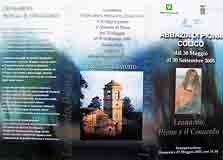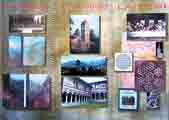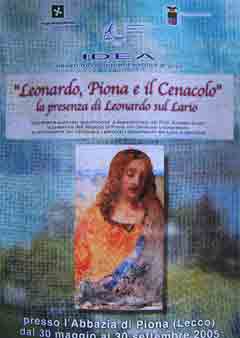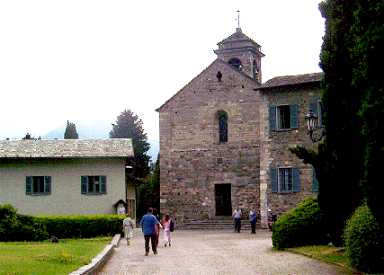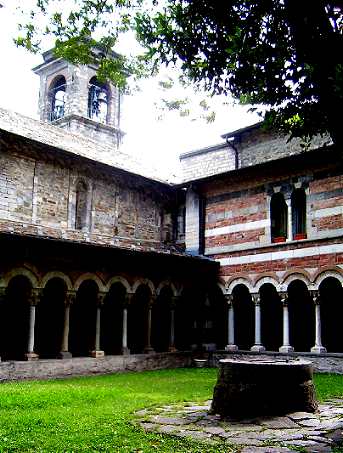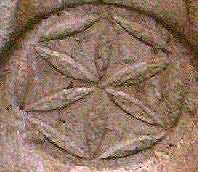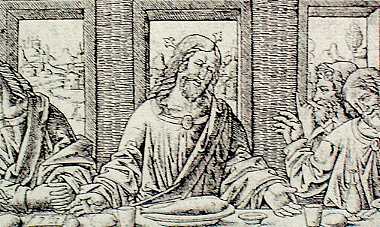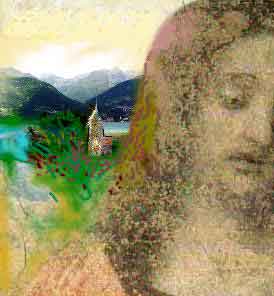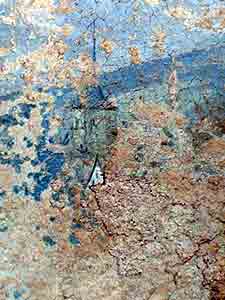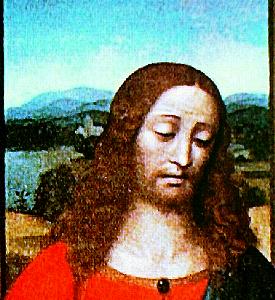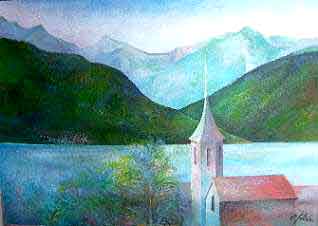LEONARDO, PIONA AND THE LAST SUPPER
Leonardo’s
Last Supper is a striking work
for its complex composition. Since its first appearance it has been
object of attention of engravers and copists; monasteries and religious
orders have competed to commission
copies of it, often altering the original structure, the groupings,
or introducing meaningful variations: Giovan Pietro da Cemmo, Antonio da
Gessate, Tommaso Aleni, Andrea Solario, Marco d’Oggiono have been
among the early promotees of the big format model, both in frescos and
“teleri” (great painted
canvas).
The
admirable restorations made by Doctor Pinin Brambilla has reproposed
this work in its original richness of colours and details, which
risked to be lost forever; amidst many “re-discoveries” it has
permitted to cast new light on the bell tower of an unidentified church,
apparently lying within a pre-Alpine lake landscape, which can be seen
from the central opening behind the Christ. In his Atlantic Code,
Leonardo talks about the Lake Como
territory and he describes it with an abundance of details which
witnesses both his love for the natural beauties that characterise its
landscape and a the Maestro’s frequent visits to the area. He writes
about his trip from the mountains around Lecco (from Resegone to Grigne)
towards Mandello to reach Gravedona and later Chiavenna.
Before
reaching Gravedona, Piona is an obliged stop.
Some
of his drawings of mountains typical of the Lecco area, now parts of the
Windsor collection, show even more the artist’s interest for these
places. It has long been pointed out that Leonardo found the inspiration
and important references for many of his works in this territory. More
specifically the views of the Virgin and Saint Ann of the Louvre and of
some Madonnas, like the Madonna Litta, appear very close to the natural
features in these areas, especially of the oriental part of the Lecco
area and that North of Valtellina.
The
investigation of the landscape in the Last Supper has led to a nearly
complete identification with that visible from the promontory of Piona-Olgiasca, which is also confirmed by the comparison with
the most important ancient copies of the painting.
The
‘landscape element’ does not constitute the only proof of the link
between Leonardo and this land. Many have sought to retrace the
histories of the families who administered these territories, and of the
people in the Sforza’s court affiliated to them and close to Leonardo.
Amongst them there is for instance Paolo Giovio, an historian from Como
and first biographer of Leonardo da Vinci. There are also Benedectine
clergymen who have lived in the Priorate
of Piona and shared its mystic rules, witnessed its successive
commandatory management,
enriched its decoration.
Special
attention has been dedicated to the reading of the symbols that
chraacterise such decorations, especially that of the Abbey and its
cloister. They single out remarkable references to Leonardo’s thought
and works, well visible in the Last Supper and in the Church that hosts
it: Santa Maria delle Grazie.
Moreover,
the investigation shows that Leonardo’s interest in Piona could also
be linked to the similarities between his own thought and that of the
Cluniac-Benedectine Order, which had founded that Abbey; and to the presence in the church’s
apse of artistic elements such as the fresco of the twelve apostles
in a similar space to that of the refectory of Santa Maria delle Grazie.
The
research underlines the possible relationships between the Maestro and
the Milanese family Birago, who had amongst his members few Prior
Commendator at Piona between
1450 and 1511. First of them was Pietro Birago, friend of Ludovico il
Moro and related to Giovan pietro Birago who produced the first print of
the Last Supper half century later with the ideal imprimatur
of Leonardo. This is another ‘coincidence’ that makes the links
between the Maestro and the Abbey
even stronger.
Prof.
Ernesto Solari
LEONARDO:
FROM THE ATLANTIC CODE
In
the papers 573 b, front and upfront of the Atlantic Code, Leonardo
examines multiple aspects related to the Lake Como
territory, the mountains and the lakes. These are real witnesses of
his frequent presence here and of his love for this area and its several
natural beauties.
LEONARDO:
FROM THE LEICESTER CODE
Leonardo
compiles this Code between 1506 and 1508. In the same period he visits the
valleys of Lombardy. Leonardo talks about those territories and describes
them with a richness of details that points out his great love for the
natural features of these places and the Maestro’s frequent presence in
the areas.
LEONARDO: LAND ROUTES…
Walking
the Via Ducale and its ramifications,
Leonardo admires the Grigne which he sketches and fixes in his
imagination to use them later in masterpieces as the Virgin and Saint Ann
of the Louvre.
The
study on the presence of these landscapes in various works and drawings of
Leonardo represents the leitmotiv of an exhibition to be produced next
year.
Other
aspects will not be overlooked: the links with the resources of our
territory and bordering areas such as the Canton Ticino (Novazzano, Ponte
Capriasca, Lugano), Saronno (Va), Milan, the area of the Adda Park, from
Paderno to Vaprio d’Adda, where Leonardo was often guest of his best
pupil: Francesco Melzi. However the most interesting aspects of the route
are surely connected to the mountains present in the Virgin of the Rocks,
which could be compared to the central massif
of Northern Grigna, composed by Sasso Cavallo and Sasso dei Carbonari.
The typical reddish colour given by Leonardo and the definition of “pelada”
would confirm such hypothesis. Another, though less plausible
hypothesis is that related to the landscape of the Annunciation of the
Uffizi, which, according to some scholars could represent the
“pizzini” of Saint Martin and Mount S. Primo in the background. It
seems more likely to us to draw the rocky mountain chain of the Saint Ann
nearer to the rocks located on the lake at Lecco-Caviate, which make up
the Horn of Medale.
LEONARDO: WATER
ROUTES…
Amongst
all the questions related to the theme of water, there is one that
Leonardo would deal with during his second stay in Milan and that excited
him above all: the urgent problem of creating a way of communication
between Lake Como and Milan in order to favour the transportation of
manufactured and agricultural products towards the urban markets,
departure points for Europe. Two were the proposals put forward by
Leonardo: overcoming the Adda waterfalls by uplifting the river’s water
through a dam and especially made up basins; and linking Lecco with the
Lambro through sailable canals connecting the basins
of the Brianza region.
LEONARDO:
ART ROUTES….
PIONA: the finding of the bell tower of the ancient Abbey of Piona and of the
surrounding landscape in the Last Supper.
THE HOLY FAMILY OF
LIPOMO COMING FROM THE PICTURE GALLERY OF PAOLO GIOVIO
On
the basis of historical hints, the painting arrived in Lipomo immediately
after the first half of the 1800s, coming from the Bonanomi Chapel in the
suppressed Church of Saint Antonio in Como., where it had been put
around 1578 by Paolo Giovio jr as new piece
on the altar following the injunction of a visiting bishop; as shown
by the fact that it was dedicated to the Holy Family instead of the
Church’s Saint. The painting arrived in Lipomo without frame since in S.
Antonio it was located inside an altarpiece
of stucco.
It is possible that Paolo
Giovio jr had taken it from the family’s picture gallery,
where the works of historian Paolo Giovio were kept.
THE
THEME OF PASSION
It
is coherent with the poetics of Leonardo on the theme of Passion.
“Leonardo
has invented a completely new mode of painting the fundamental event of
the Christian dogma, the inevitable Passion and Death of Christ. We know
that this had been subject of a work examined by Father Pietro da
Novellare in 1501, right at the time when the artist was planning the
Madonna of the fuses. In his letter of April 3rd addressed to
Isabella d’Este the father describes the postures of Christ (a child of
about one year of age), embracing a lamb, His Mother and Saint Ann….
